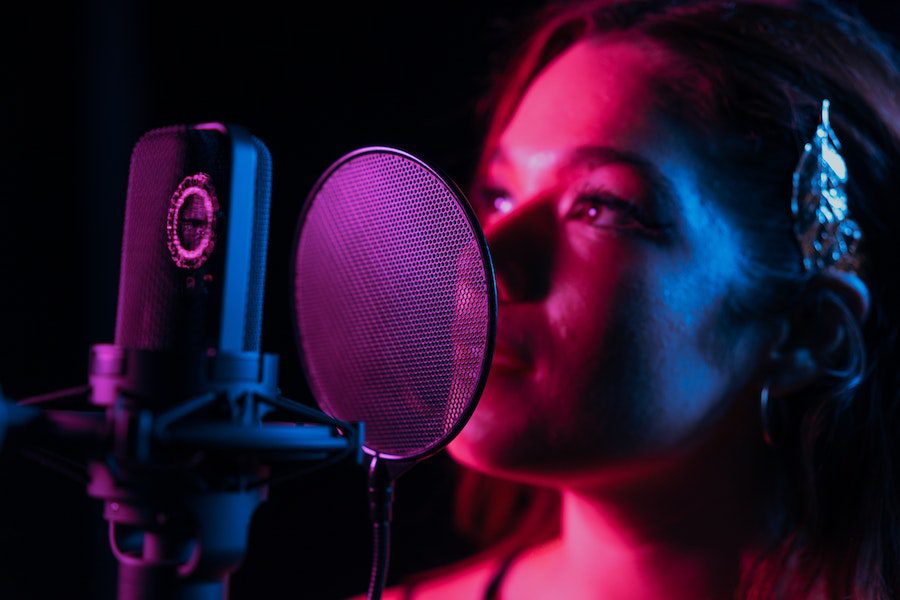In audio recording, achieving high-quality sound is crucial for any vocalist or voice-over artist. One essential tool for maintaining crisp vocal quality is the pop filter. A pop filter minimizes plosive sounds, such as the “p” and “b” consonants, which can create unwanted noise when pronounced too close to the microphone.
While a pop filter is critically important for vocal clarity, determining the optimal distance between the filter and the microphone can be debated. A pop filter should generally be positioned approximately 2-4 inches away from the microphone to ensure the best audio results. This allows the filter to effectively minimize plosive sounds without negatively impacting the overall audio quality or causing any diminishing in vocal tones.
However, it’s important to note that this suggested distance may vary depending on the specific microphone used or the individual’s vocal projection. Experimenting with different distances and setups can help audio professionals find the perfect balance for their unique recording needs.
Table of Contents
- Importance of Pop Filters
- Ideal Pop Filter Distance
- Adjusting Pop Filter Position
- Popular Pop Filter Types
- Conclusion

Importance of Pop Filters
Pop filters are essential tools in the world of professional audio recording. Their primary purpose is to minimize the harsh sounds, known as plosives, that can occur when a singer or speaker pronounces certain letters, such as “p” or “b.” Plosives can generate a sudden burst of air that hits the microphone, causing distortion and negatively impacting the overall audio quality.
Placing a pop filter between the vocalist and the microphone makes these unwanted sounds diffused before they reach the microphone’s diaphragm. This is crucial for preserving the natural tone of a singer’s voice and ensuring that recordings sound clean and polished.
Pop filters can be made of various materials, such as metal or nylon mesh. Regardless of their composition, they all function similarly in the recording process. Some benefits of using pop filters include the following:
- Reducing the occurrence of plosives
- Maintaining consistent audio levels
- Protecting the microphone from moisture and saliva
- Helping to achieve a more professional sound
When using a pop filter, it is essential to position it correctly to achieve optimal results. A recommended distance is at least two inches between the filter and the microphone; however, this may vary depending on microphone sensitivity and vocal performance style.
Ideal Pop Filter Distance
Finding the ideal distance is crucial to achieving clear and crisp audio when setting up a pop filter for recording. This section will provide general guidelines and discuss factors affecting the ideal distance, such as microphone type, singing style, and the acoustic environment.
General Guidelines for Pop Filter Distance
Although the ideal distance may vary depending on the factors mentioned, a general recommendation is to position the pop filter around 2-4 inches (5-10 cm) away from the microphone. This distance allows the filter to effectively diffuse plosives while maintaining audio quality and preventing unwanted noise.
Experimenting with different distances is essential to find what works best for your specific setup and recording needs. Adjusting the distance incrementally while monitoring the audio can help identify the optimal placement.
Factors Affecting Distance
Several factors can influence the ideal pop filter distance for a particular recording situation. These factors include:
- Microphone Type: Different microphones have different sensitivities to plosives and recording patterns. For example, condenser microphones are typically more sensitive than dynamic microphones and may require a slightly larger distance from the pop filter.
- Singing Style: A more aggressive and powerful singing style with lots of plosives may require a greater distance between the pop filter and microphone, while a softer vocal style may allow for a closer placement.
- Acoustic Environment: In rooms with more reverb, reflections can cause the unwanted noise to be more noticeable, and a greater distance may be necessary. A well-treated space may allow closer pop filter placement without sacrificing audio quality.
Considering these factors when setting up your pop filter can significantly improve your recording quality and help you find the ideal distance for your specific needs.
Adjusting Pop Filter Position
When setting up a pop filter, balancing effective plosive reduction and maintaining optimal audio quality is essential.
One of the most common ways to find the ideal pop filter position is through trial and error. Experimenting with various distances can help determine the best placement for your recording environment and microphone.
Monitoring the audio results while adjusting the pop filter’s position is crucial to achieving the best sound quality. By listening closely to the recorded audio, you can identify unwanted plosive sounds and make necessary adjustments to the pop filter’s location. It is recommended to wear closed-back headphones while monitoring the recordings for a more accurate representation of the sound.
Consider some helpful guidelines when adjusting your pop filter position:
- Keep a distance of 2-4 inches (5-10 cm) between the microphone and the pop filter.
- Ensure the filter does not touch the microphone, as vibrations can transfer and affect the recording.
- Adjust the angle of the pop filter to cover the microphone’s capsule effectively without obstructing the sound source.
In conclusion, the ideal pop filter position varies depending on individual preferences, microphone type, and recording situations. Using trial and error combined with monitoring audio results will help you find the optimal placement for clear and plosive-free recordings.
Popular Pop Filter Types
When considering which pop filter to use, you must know the popular types available to help you make the right choice. The materials used and the attachment style are the two main factors to consider. We will briefly discuss nylon vs. metal pop filters and gooseneck vs. clamp-style attachments.
Nylon vs. Metal Pop Filters
Nylon pop filters typically use a double-layered mesh to reduce plosive sounds effectively. They are known for their affordability and ease of use, making them popular among home studio owners and podcasters. You could even try making your own DIY Pop Filter. Some advantages of nylon pop filters include the following:
- Cost-effective
- Lightweight
- Good plosive reduction
On the other hand, metal pop filters use a single layer of perforated metal to remove plosives without disrupting the clarity of the sound. Metal pop filters usually offer better durability and often have a sleeker appearance. Some advantages of metal pop filters are:
- Long-lasting
- High-quality sound
- Stylish design
Gooseneck vs. Clamp Style Attachments
Gooseneck pop filters offer flexibility in positioning as they can be bent and adjusted to the desired angle easily. They often have a sturdier arm, ensuring stability during recording. Some benefits of gooseneck pop filters include:
- Flexible positioning
- Stable attachment
- User-friendly
Clamp-style pop filters, in contrast, utilize a simple clamp mechanism directly attached to a microphone or mic stand. They are typically more compact and portable compared to gooseneck attachments. Some benefits of clamp-style pop filters are:
- Compact design
- Easy installation
- Portability
Conclusion
In conclusion, a pop filter plays a crucial role in improving the quality of vocal recordings by reducing plosive sounds. Positioning the pop filter at an appropriate distance from the microphone is essential for optimal performance.
Generally, the recommended distance for placing a pop filter is approximately 2 to 4 inches (5 to 10 cm) away from the microphone. This distance allows the filter to reduce plosives while maintaining the integrity of the recording effectively.
Depending on individual voice characteristics and recording environment factors, adjusting the pop filter distance may be necessary. Ultimately, trial and error will help determine the best configuration for each situation.
By paying attention to these simple guidelines, one can ensure a more professional and polished vocal recording, enhancing the overall clarity and quality of the audio.
- Review of the ALABS IRON MINI-WL: A Powerhouse Wireless Microphone - October 4, 2023
- What is a Saturator in Music Production: A Brief Explanation - May 11, 2023
- What Are Rotary DJ Mixers? An Overview - May 11, 2023
SoundStudiomagic.com is a participant in the Amazon Services LLC Associates Program, an affiliate advertising program designed to provide a means for sites to earn advertising fees by advertising and linking to Amazon.com. We also participate in other affiliate programs which compensate us for referring traffic.

